Tropical Entomology - Diaprepes, Root Weevil
Diaprepes abbreviatus (Coleoptera: Curculionidae)
-
Description
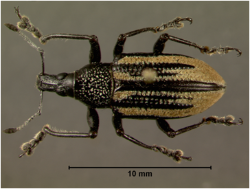
Diaprepes abbreviatus (L.) (Coleoptera: Curculionidae) is a root weevil native to the Lesser Antilles that immigrated to Florida in the mid-1960s (Woodruff, 1985). The list of host plants of Diaprepes includes more than 270 plant species from 60 plant families (Simpson et al., 1996; Mannion et al., 2003). The adult weevils vary in length from 1 to 2 cm. They are black, with red orange, and/or yellow stripes on the elytra.
-
Damage
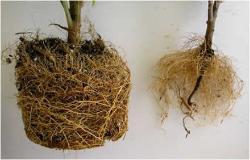
Part of plant damaged: Roots, leaves
Adults prefer to feed on young, tender leaves, leaving characteristic semi-circular notches. They may also feed on old leaves or to a limited degree on fruits (Woodruff 1968, Knapp et al. 2000). The larvae cause major crop damage by debilitating the root system, making it more vulnerable to infection by soil born pests such as Phytophtora spp. and nematodes, and less tolerant to water stress. If no control measures are taken, a few large larvae can turn a mature healthy tree to a non-productive one.
-
Life Cycle
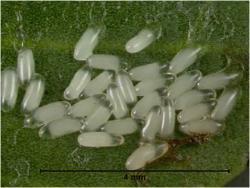
Diaprepes eggsThe adult weevils are long lived (~147 days females and ~135 days for males; Wolcott, 1936) and can be found throughout the year in south Florida. Diaprepes adults form aggregations of equal sex ratio on new foliage of their host plants, where they can remain for weeks. Females oviposit egg masses between two adjacent leaves. The egg masses are deposited in gelatinous cement that seals the leaves together and provides protection for the eggs (Jacas et al., 2005, Nigg et al., 2001). Females lay eggs in clusters of 30 to 265 eggs and can deposit approximately 5000 eggs over their life time (Wolcott, 1936). Upon emergence, the neonate larvae escape from the sealed leaves and drop to the soil surface. Larvae burrow down to the root system where they begin feeding on fibrous roots. As they grow, the larvae move to feed on larger structural roots, creating profound grooves. The larval development period may include up to 16 instars and varies widely even between the individuals of a single mass.
-
Management
Monitoring and Action Levels
Detection of Diaprepes has relied mostly on observation of the adult stage. Visual monitoring for adults can be effective when a grove is inspected on a regular basis by looking for the distinctive semicircular notches on leaves resulting from adult feeding, especially in new flushes. If leaf notching is observed, it is necessary to capture the adults in order to obtain a positive identification. A capture method used by growers is the "beat" method, the adult weevils can be captured by placing an open umbrella or a cloth between the tree and the ground and then beating the tree.
Biological Control
The other major component of the management programs of Diaprepes is biological control. Various predators, entomogenous nematodes, entomophatogenic microorganisms and egg parasitoids have been found to affect Diaprepes eggs and/or larvae. Two eulophid parasitoids (Quadrastichus haitiensis (Gahan) and Aprostocetus vaquitarum (Wolcott)) were introduced as classical biological control agents and have successfully established in the southern portion of the Florida peninsula where they have become an important mortality factor of Diaprepes eggs (Peña et al. 2004, 2006).
Chemical Control
Chemical control proposed for Diaprepes has two components: foliar sprays and chemical soil barriers. Foliar sprays target the adult weevils with the purpose of reducing egg deposition, thereby limiting the number of neonate larvae entering the soil. The products recommended for foliar sprays are often mixed with petroleum oil to improve their residual effect and to affect the bonding characteristics of the secretions that females use to bond eggs to leaves (Rogers and Timmer, 2007). Recommended pesticides include: carbamates (Sevin XLR, 80S & 4F), organophosphates (Orthene 97, Imidan 70WP), minerals (Kryocide 96WP), pyrethroids (Danitol 2,4EC) and insect growth regulators (Micromite 80WGS). Timing is critical to maximize the effect of foliar sprays, obtaining the best results by targeting the peaks of adult emergence (Rogers and Timmer, 2007). Chemical soil barriers are used to prevent the neonate larvae from burrowing into the soil and reaching the root system. Two pyrethroids (Brigade WSB and Capture 2EC) are recommended as chemical soil barriers that are more effective when applied two weeks after the peak of adult emergence (Rogers and Timmer, 2007). The presence of Diaprepes in a grove induces the application of soil fungicides to control infections of secondary pathogens (i.e. Phytophthora spp.) (Rogers and Timmer, 2007).
Cultural Control
Cultural practices such as keeping optimal soil drainage is proposed for reducing infections of secondary pathogens in the root system (Rogers and Timmer, 2007). Another recommended agronomic practice is to apply additional fertilizers to promote new root growth after Diaprepes larvae have inflicted damage to the roots.
Fact Sheets
-
Images
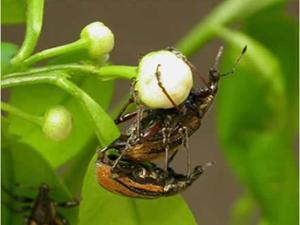
Adult Diaprepes weevils mating
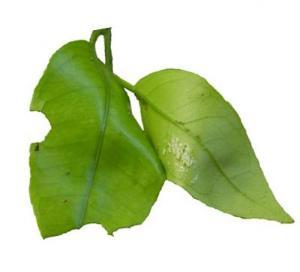
Diaprepes eggs on citrus leaf
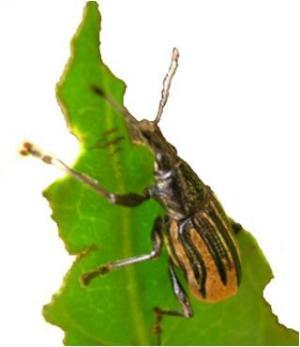
Adults feed on young, tender leaves, leaving characteristic notches
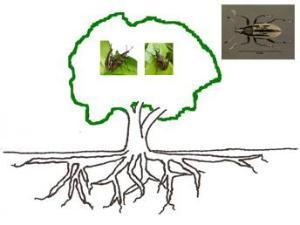
Adults mate, feed and oviposit on the foliage
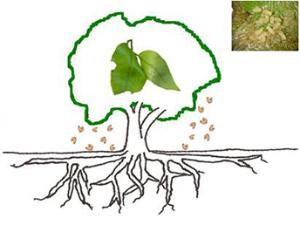
Upon emergence larvae fall to the ground
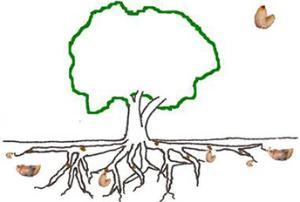
Larvae feed on roots and pupate in the soil

